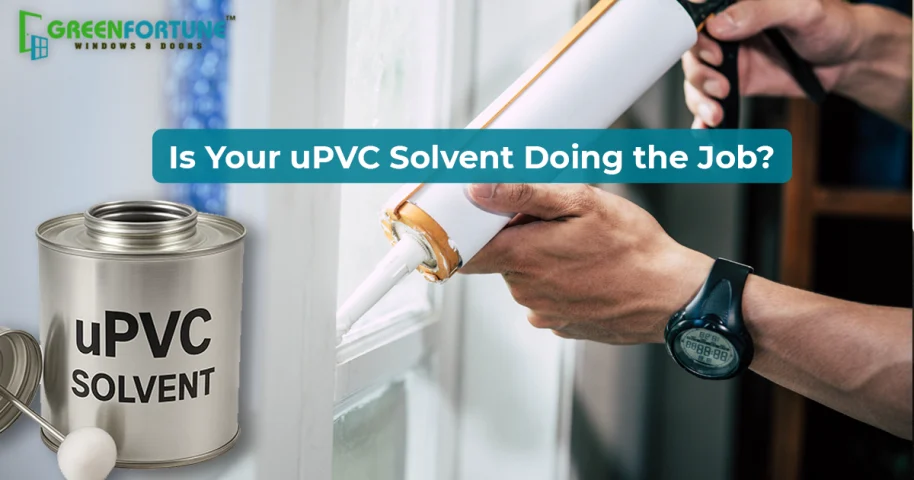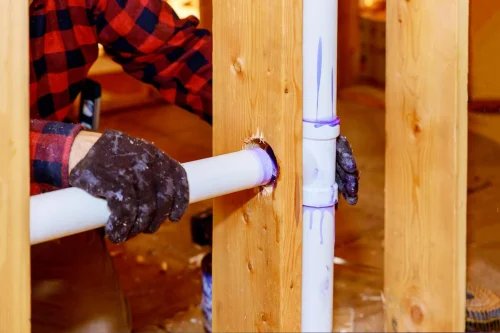
How much do POP and Gypsum false ceilings cost per square foot?
April 29, 2025
Top 10 Concrete Wall Designs for a Stylish and Modern Home
April 29, 2025When you’re working on home plumbing projects, you want the best water pipes for your home. If you choose uPVC pipes, you’ll also need uPVC solvent. Unlike threaded connections or push-fit systems, uPVC pipes require a chemical adhesive to form a strong, leak-proof bond.
Here is a complete guide for you to understand uPVC solvent, how it works, and the technical details to make sure your plumbing is in great shape in the long run.
What Is a uPVC Solvent?
A uPVC solvent is a chemical adhesive used to join uPVC pipes and fittings by creating a watertight, permanent bond. It’s not like ordinary glue. uPVC solvent cement works by softening the plastic at the joint, allowing the pipe and fitting to fuse as it dries.
Once it dries, it holds up well against water pressure and temperature changes and makes it ideal for leak-proof plumbing systems.
uPVC Solvent Types and Application Methods
Category | Standard uPVC Solvent | Fast-Setting uPVC Solvent Cement |
Description | It is a commonly used solvent that provides a longer working time before setting. This extra time allows users to properly align and adjust pipe fittings, which is especially helpful when working with complex layouts or large-diameter pipes. | This solvent is designed to bond quickly after application. It significantly reduces curing time and makes it ideal for jobs that require a fast turnaround or when working in time-sensitive conditions. |
Recommended Application Method | Brush Application – A brush is used to apply the solvent evenly to both the pipe and fitting. This method ensures full coverage and better control, reducing the risk of excess solvent and improving joint quality. | Direct Squeeze – The solvent is applied directly from a tube or squeeze bottle. This method is quicker but requires precision, as uneven application can lead to weak bonding. |
Best Use Case | It is suitable for larger plumbing installations, such as home water supply lines, where precision and flexibility during assembly are important. | It is ideal for quick repairs or small-scale projects where speed is a priority, such as fixing a single joint or replacing a short pipe section. |
User Mistakes That Ruin Bonding
Even though uPVC solvent is a reliable bonding solution, these common mistakes can still compromise the joint.
1. Not Cleaning the Pipe and Fitting
Clean both the pipe and fitting thoroughly with a cloth and make sure they’re dry before you begin. Any dirt, dust, or oil can interfere with the bond strength.
2. Applying Too Much Solvent
It might seem like more solvent will create a stronger bond, but it's a wrong assumption. Excess uPVC solvent can lead to a messy joint and weaken the bond. Apply only a thin and even coat.
3. Not Waiting Long Enough for Drying
Let the bond dry completely. Insufficient time to cure can weaken the joint. Always follow the drying time instructions mentioned on the solvent can.
4. Incorrect Pipe Alignment
Make sure the pipe and fitting are properly aligned before pushing them together. Once the solvent starts to set, you can't adjust the position, as any movement during the drying phase weakens the bond.
Signs and Solutions for Improper Bonding
If the bond hasn’t fully cured, you may notice a few signs:
- Leaks around the joint
- Gaps between the pipe and fitting
- Soft or weak spots in the joint
- Discoloration or an unusual texture on the pipe or fitting
If you observe any of these, here’s what you can do to resolve it:
- Cut the Affected Section: Use a pipe cutter or hacksaw to gently remove the damaged part.
- Smooth the Edges: Once cut, smooth the edges with sandpaper or a pipe reamer to prepare the surface.
- Reconnect the Pipe: Clean both surfaces and ensure they’re dry, then apply a new layer of uPVC solvent.
- Reassemble the Fitting: Carefully push the fitting onto the pipe, give it a slight twist, and hold for a few seconds to ensure it’s securely bonded.
When NOT to Use Solvent Cement
There are some situations where uPVC solvent isn’t the right choice:
- uPVC solvent cement should not be used with pipes such as metal pipes or CPVC.
- If you need a temporary connection, uPVC solvent is not the right option, because it forms a permanent bond.
If the plumbing system is exposed to extreme heat or harsh chemicals, the bond may not hold up.
Final Takeaway
uPVC solvent is essential for creating secure, long-lasting joints in your plumbing system that can withstand pressure and prevent leaks.
Looking for quality uPVC doors, windows, or profiles? Greenfortune offers premium options that combine durability with modern design - built to last and made to impress.
FAQs
1. Can uPVC solvent be used for both indoor and outdoor plumbing?
Yes, uPVC solvent works for both indoor and outdoor plumbing. For outdoor use, it's important to protect the pipes from prolonged sun exposure, as UV rays can degrade the plastic over time.
2. How long does it take for uPVC solvent to fully cure?
It typically takes 24 hours for uPVC solvent to fully cure, but you can handle the pipes after a few hours.
3. Is uPVC solvent safe to use in confined spaces?
uPVC solvent should be used in well-ventilated areas. If working in a small space, ensure good airflow or wear a mask to avoid inhaling fumes.
4. Are there eco-friendly or low-VOC uPVC solvent options?
Yes, there are low-VOC (volatile organic compounds) and eco-friendly uPVC solvents available. These options are safer for indoor use in poorly ventilated spaces and are a better choice for the environment while still providing a strong bond.








